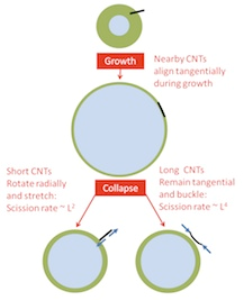A new study conducted by scientists at Rice University demonstrates the mechanism behind snapping of nanomaterials when subjected to ultrasonic vibrations within a liquid.
 The mechanism by which carbon nanotubes break or bend under the influence of bubbles during sonication is the topic of a new paper led by researchers at Rice University
The mechanism by which carbon nanotubes break or bend under the influence of bubbles during sonication is the topic of a new paper led by researchers at Rice University
Carbon nanotubes are hollow tubes of pure carbon that measures similar to a DNA strand in width. It is one among the frequently observed materials in nanotechnology. For more than 10 years, ultrasonic vibrations have been employed for the synthesis and separation of nanotubes in the lab. In this new study, Pasquali and his co-workers demonstrate this process and its impact on long nanotubes. This process is critical for studying and developing long nanotubes.
Carbon nanotubes were identified two decades ago and are considered to be among the original wonder materials of nanotechnology. These are similar in properties to buckyball.
Nanotubes can be incorporated in sensors and paintable batteries for diagnosis and treatment of disease, and for advanced power cables in electrical grids. Nanotubes’ material and optical properties were identified at Rice’s Smalley Institute for Nanoscale Science and Technology. The initial large-scale manufacturing method for creating single-wall nanotubes was detected at Rice by the late Richard Smalley, the institute’s namesake.
Newly produced nanotubes have increased length than width. Despite the efficiency of sonication in breaking up the clumps, it reduces the size of nanotubes. The researchers also formulated the “power law” equation demonstrating the effect of shortening. Based on the sonication power and the period of sonication of sample, the power law represents the average length of the nanotubes being manufactured. The length of nanotubes reduces with respect to increase in power and exposure time.
In order to analyze this discrepancy, Pasquali and study co-authors Poulin, Guido Pagani, and Micah Green will precisely model the interactions between the sonication bubbles and nanotubes. Their computer model being programmed at Rice’s Cray XD1 supercomputer is based on an integration of fluid dynamics techniques for precisely simulating the interaction. Longer tubes behaved quite unusually from their shorter counterparts under simulations.